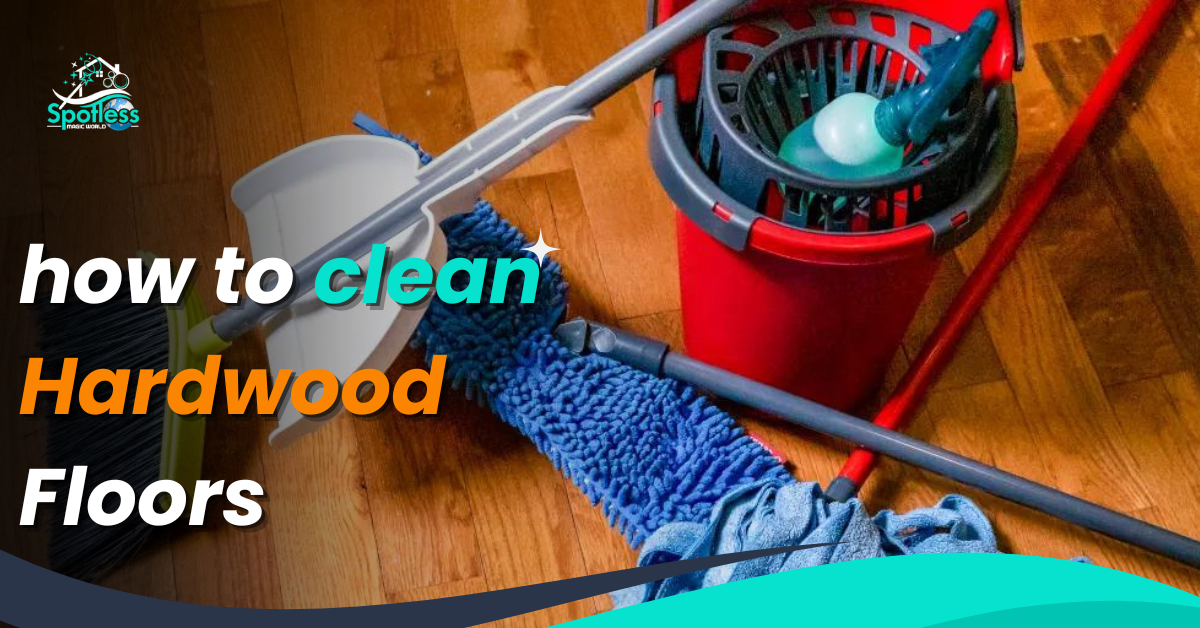Licensed And Insured

how to clean hardwood floors
Hardwood floors are a treasured feature in many homes, adding a natural, warm beauty. These floors are not just beautiful but also durable. With the right care, their shine and condition can last for years.
While plenty of products out there promise to polish, shine, or rejuvenate your floors, the key to lasting beauty isn’t in a bottle—it’s in how you care for the wood day to day.
This article is your detailed guide on how to clean hardwood floors properly. With this guide, your floor care will be easy and effective. So, without wasting any more time, let’s dive in.
How to Clean Hardwood Floors
Cleaning wooden floors requires remembering the most important thing: never let it get wet. Don’t clean your floor with a mop that is too wet. The standing water can damage the wood.
Moreover, avoid using harsh acidic cleaners like white vinegar and lemon juice to maintain the quality. To properly care for your wood floor, follow these steps.
- Sweep or dust your floors daily.
- Spot clean promptly.
- Vacuum every few days.
- Wet mop when needed.
Below, you’ll find detailed guidance for each step, ensuring your floors stay clean and vibrant without risking damage.
Step-by-step instructions
- Sweep or dust your floors daily.
Daily sweeping or dusting is essential in wood floor maintenance. This routine prevents the accumulation of dirt that can scratch and dull the surface over time.
For best results, opt for a soft-bristled broom or a microfiber mop. The soft bristles of the broom gently sweep away loose dirt without damaging the wood, while a microfiber mop attracts and traps dust particles through its static charge, ensuring a thorough clean.
To clean the hardwood floor, start from a corner and work towards the room’s exit, following the wood’s grain to capture the most dirt. Integrating this simple step into your daily routine keeps your floors looking their best and protects them from wear, preserving their beauty and longevity.
-
Spot clean promptly
Promptly spot-cleaning spills are crucial for maintaining the integrity and appearance of your hardwood floors. When a spill happens, wiping it up with a damp cloth is imperative.
This quick action prevents the liquid from seeping into the wood. It can cause staining or even more severe moisture damage over time. Water and other liquids can warp the wood, leading to costly repairs or replacement.
For sticky or tough spills, a mild dish soap solution mixed with water can assist in removing the residue without harming the floor’s finish. Always finish by drying the area thoroughly with a soft, dry cloth to ensure no moisture remains.
This approach not only keeps your floors looking their best but also protects your investment by avoiding potential water damage and the expense of refinishing the floors prematurely.
By incorporating spot cleaning into your floor care routine, you’re taking an essential step in preserving the beauty and longevity of your hardwood floors.
- Vacuum every few days
Vacuuming regularly is a key step in cleaning hardwood floors. It offers a deeper clean than daily sweeping alone. Utilizing a vacuum cleaner equipped with a soft-brush attachment allows you to gently yet effectively remove dust, pet hair, and debris from those hard-to-reach areas that brooms and mops might miss, such as corners and under furniture.
Selecting the ‘hardwood’ setting on your vacuum is crucial if available. This setting ensures the vacuum operates at a safe level for your floors, minimizing the risk of scratches or other damage.
By incorporating regular vacuuming into your cleaning routine, you’re not just removing visible dirt but also contributing to a healthier home environment by reducing allergens and improving air quality. This simple step plays an important role in preserving the beauty and extending the life of your hardwood floors.
- Wet mop when needed
Wet mopping your hardwood floors should be done sparingly and carefully to prevent potential water damage. A damp mop can effectively remove dirt and grime when a deeper cleaning is necessary beyond daily dusting or vacuuming.
However, it’s crucial to wring out the mop thoroughly before use, ensuring it is only barely wet. This minimal moisture approach is key to protecting your floors. Excessive water can cause swelling, warping, or even discoloration of the wood.
When mopping, aim for a swift and efficient pass over the floors, focusing on areas that are visibly dirty or have sticky residues. After mopping, brushing the floors with a dry, soft cloth can help pick up any residual moisture, leaving your floors clean, protected, and without streaks.
By mopping only as needed and ensuring the mop is properly wrung out, you safeguard the integrity and beauty of your hardwood floors, maintaining their condition and prolonging their lifespan.
Tips to remove scuff marks
Removing scuff marks from hardwood floors can be surprisingly simple with the right approach, ensuring your floors continue to look their best. Here are some effective tips for dealing with these common blemishes:
Tennis Ball Method: A clean, new tennis ball can be gently rubbed over the scuff mark to erase it.
Eraser Pad: Magic eraser pads are mildly abrasive and work wonders on scuff marks. Lightly dampen the pad and gently rub it on the scuff until it disappears. Be careful to use minimal pressure to avoid harming the floor’s finish.
Baking Soda Paste: A baking soda mixed with water paste can be effective for tougher scuff marks. Apply it on a clean cloth and softly rub the mark in a circular motion. Then, clean the area with a damp cloth and dry it thoroughly.
Olive Oil and Vinegar: A mixture of olive oil and vinegar can help remove scuff marks while nourishing the wood. Mix equal parts of both elements in a bowl and apply a small amount to a soft cloth, and rub the mark gently.
Preventive Measures: Place felt pads under furniture legs to prevent scuffs and scratches. Encourage guests and family members to remove shoes at the door to avoid bringing in grit that can cause scuff marks.
Remember, before trying any method, it’s wise to test it on a small area of your floor to ensure it doesn’t damage the finish. With these tips, keeping your hardwood floors free from unsightly scuff marks can be an easy addition to your regular cleaning routine.
Tips to keep hardwood floors clean longer
Keeping your hardwood floors clean longer requires a blend of preventive measures and smart cleaning strategies. Here are some effective hardwood floor cleaning tips to extend the cleanliness of your hardwood floors:
- Place doormats both inside and outside all exterior doors. They catch much dirt and grit that could be tracked onto your floors.
- Encourage household members and guests to remove shoes to minimize dirt and debris upon entering.
- Use a microfiber mop or cloth for daily dusting. This material captures dirt, dust, and hair without scratching the floor.
- Wipe up spills as soon as they happen to prevent stains and moisture damage.
- Attach felt pads to the bottoms of furniture legs to prevent scratches and scuffs when moving furniture.
- Protect your floors from prolonged sun exposure, which can fade and discolor wood, using curtains or blinds during peak sunlight hours.
- Only use cleaners specifically designed for hardwood floors. Avoid using water and vinegar or steam cleaners, which can damage the finish.
By following these simple yet effective tips, you can keep hardwood floor maintenance and preserve the beauty and longevity of your hardwood floors, keeping them clean and in pristine condition for longer.
Wrapping Up
The key to preserving the natural beauty and longevity of your hardwood floors lies not in the latest commercial polish or rejuvenation product but in adopting a consistent and careful cleaning routine. Additionally, addressing scuff marks gently and employing preventive strategies further ensures that your hardwood floors remain a timeless and cherished feature of your home.
Get the best house cleaning tips and services from the spotless magic world. Hire our skilled team to get rid of any complicated wooden floor cleaning. Contact Us now.
FAQ
What is the best thing to use to clean wood floors?
The best thing to clean hardwood floors is a cleaner specifically formulated for hardwood floors, paired with a microfiber mop or cloth. This combination ensures effective cleaning without risking damage to the floor’s finish or introducing too much moisture, which can harm the wood. Always follow the cleaner’s instructions for the best results.
How do you clean and shine hardwood floors?
To clean hardwood floors, first, vacuum or dry mop to remove dust and debris. Then, apply a hardwood floor cleaner or a diluted pH-neutral soap with water with a damp (not wet) microfiber mop. To add shine, apply a thin layer of hardwood floor polish or wax after cleaning, following the product’s instructions carefully. Ensure the floor is dry before applying polish or wax to avoid trapping moisture.



